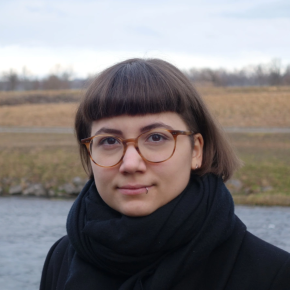[They chose France series #3] Lea Maria Ibele joins the Institute of Radical Chemistry
After a Ph.D. at Durham University, United Kingdom, and a postdoctoral fellowship at Paris-Saclay University, Lea Maria Ibele is joining the Institute of Radical Chemistry in Marseille for her research in theoretical photochemistry. She tells us more about her background, her motivations to apply to the CNRS, and her prospects for the coming years.
Could you tell us a little about your background and research topics?
I did both my B.Sc. and M.Sc. in general chemistry at the University of Vienna. From the very first year, I became fascinated by quantum mechanics and soon decided that my passion lied in the interface between chemistry and physics. Since life on earth happens under constant exposure of light, I wanted to understand the influence of this light on the chemistry happening in our world. All these interests combined lead me to the field of theoretical photochemistry. This motivated me to investigate the states formed in single-stranded DNA upon the excitation with light during my master’s thesis at the University of Vienna, working with Leticia Gonzalez.
I then wanted to learn more about different approaches how to simulate the response of molecules to light. For my Ph.D., I joined Basile Curchod’s new group at Durham University, United Kingdom. Working with an international team of experimentalists, I studied a heterocyclic molecule using a free-electron laser1 . This facility allowed us to map in real time the ultrafast photochemistry: we were able to observe how the atoms in the molecule rearrange within hundreds of femtoseconds2 . The synergy between my simulations and spectroscopic studies let us identify several different molecules that were formed due to the light excitation.
Following my Ph.D., I came to France as a postdoctoral researcher to work with Federica Agostini at Paris-Saclay University. There, I dived deeper into the theoretical foundations of photochemistry, further developing new simulation methods for molecular photodynamics. This involved simulating the coupled evolution of electrons and nuclei after the molecule absorbs light.
In my current research, I develop methodologies to simulate the response of molecules to the interaction with light. In particular, I want to improve the simulation of fluorescence, the emission of light by molecules after absorption. These processes are not just aesthetically pleasing, as in bioluminescence. They also have important applications, for example in fluorescent probes or organic lasers. I am trying to elaborate a framework that will allow us, for the first time, to simulate at equal footing nuclei, electrons and photons. This work has the potential to give us a much better understanding of molecules’ fluorescence.
What motivated your application to the CNRS?
During my postdoctoral fellowship at Paris-Saclay University, I got introduced to the French academic system. I was immediately intrigued by the CNRS, a unique institution that creates a great environment for impactful scientific research. Despite applications and offers for positions in other countries, the general working environment appealed to me and made me choose France.
When I decided to apply to the CNRS, I was looking for groups that would best fit my research plans. Being a computational chemist, I had more possibilities as I am not dependent on specific laboratory and experimental equipment. I was very happy to find a strong support from the Theoretical Chemistry group at the Institute of Radical Chemistry (ICR – CNRS/Aix-Marseille Université), which I eventually joined this year as a tenured researcher.
What differences have you noticed between your previous work environment and the one you are discovering here?
The university system in France is quite unique in the world, with groups being formed of several independent permanent researchers. More generally, the working conditions in France have a much higher standard than in other countries. Researchers can keep a healthy work-life balance, without sacrificing scientific excellence. I appreciate this system that leads to a very collaborative and productive environment.
Do you still have ongoing projects with Austria and the UK?
During my master’s thesis in Leticia Gonzalez’s group and my Ph.D. with Basile Curchod, I was able to meet many young researchers. I am still actively collaborating with them as they are starting to build their independent careers all around Europe. Recently, the molecular photodynamics community has endeavored to develop a standardized benchmark set, i.e. elaborating hard tests that everyone going forward will evaluate their new methodologies on. Together with three young researchers I met throughout my scientific path, we were able to bring together most of the leading groups in Europe and beyond in the field of excited-state dynamics.
In Austria, I am also deeply engaged in outreach activities. I was honored to join the “Calliope Join.The.Dots” project that showcases and promotes Austrian women in science, arts, and media. I have been working in this framework to disseminate the beauty of photochemistry to children, in particular to young girls.
What are your prospects for the coming years?
I am planning to establish my research team at the Institute of Radical Chemistry. The Theoretical Chemistry group has been offering me a very stimulating and supporting work environment, where I can benefit from my colleagues’ complementing expertise and contribute my own experiences and research directions. As outlined in my research program for my CNRS application, I am planning to work on the simulation of fluorescence of molecules, advancing the state-of-the-art of the computational toolkit available.
I hope to be able to grow my own research team through grants from the ANR [French National Research Agency] and local funding opportunities. I also plan to apply for European Grants, such as the ERC Starting Grant. Finally, I hope to establish new collaborations with experimentalists in France and abroad to work in synergy to uncover the photochemistry of many interesting molecules.
Editor: CD

“They chose France”
“They chose France” is a series that aims to highlight the careers of foreign researchers recruited in CNRS Chemistry laboratories in 2024.
